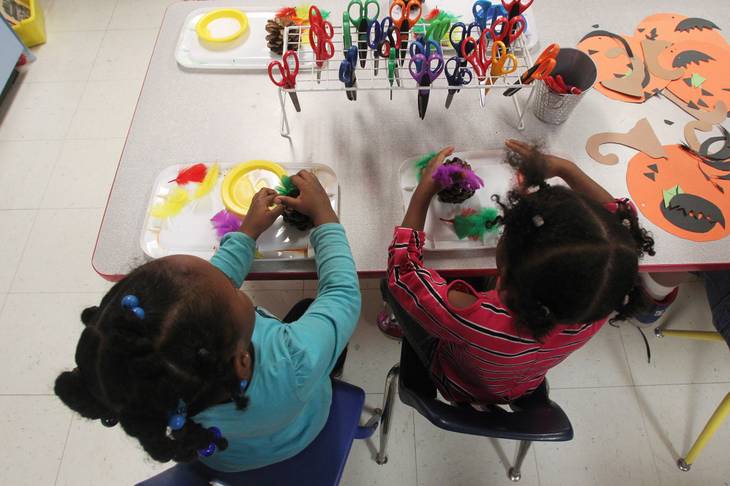It’s 10:30 p.m. Time for most children to wind down. But this is Las Vegas, where the average concept of sleep and child care doesn’t apply.
At the Children’s Choice Learning Center, a local child care facility for employees of MGM Resorts International, you’ll find about a dozen kids getting creative with glue and colored paper, playing with puzzles or flipping through pictures books into the wee hours.
Working while raising kids can be difficult for anyone. But the challenges can be compounded in Las Vegas, a 24-hour town where work schedules often start at a time most people are tucking in their kids — and long after most day care centers have closed. Child care facilities are a fact of life for some families struggling to balance work and family.
Barbara Cahill, a 38-year-old single mother and housekeeper at the Mirage, takes her kids to Children’s Choice when she can afford it. She needs all the help she can get. She works the morning shift — from 8 a.m. to 5 p.m., or sometimes longer — to support her two children, ages 7 and 10.
Without their father in the picture, Cahill says, “it’s hard.”
That’s where places like Children’s Choice can help, says Monica Sparta, the center’s director.
Children’s Choice is open 24/7. On an average day, more than 300 children come in and out — that’s why the center employs more than 100 caretakers, a cadre of nurses and five full-time cooks.
Take a walk through its halls and you’ll notice the bright sky-blue walls painted with clouds, decorated with balloons and populated with cartoon lions and dogs.
In the infant section, most babies are sleeping or rolling around in their cribs, getting their diapers changed or playing peek-a-boo with passing visitors. Even though parents are not there, they can get real-time updates from a caregiver armed with an iPad. An app called “Baby Connect” sends parents text messages announcing feedings, diaper changes and naps.
There’s an infirmary, equipped with separate air ducts, for sick children.
Stroll past the classrooms for children between 13 and 24 weeks old and you’ll find art — construction paper covered in squiggly lines made with crayons that still makes parents darn proud.
The art gets more sophisticated as you walk through the center and the kids get bigger. By preschool, the children know an apple is red. They know their hair is brown or blond or black. There’s poster on the wall that says, “My hair is brown” or “My hair is black,” and pasted next to those are cutouts of the names and faces of dark-haired students.
By first grade, they’re drawing apples and their friends. By third grade, they’re trading apples at lunch and cutting out shapes of leaves and pumpkins to decorate the classroom for Halloween.
The activities — whether they're games or projects — are all tailored for learning. In the first-grade classroom, you’ll find a run embroidered with the shape of the United States.
The graveyard shift at Children’s Choice runs from 10:30 p.m. to 6 a.m. By then, the children have been whittled down to fewer than 20. Some are sleeping. Others stay awake; their parents prefer that they stay on the same sleep schedule.
“We can accommodate any shift,” said Jeff Ellis, vice president and CFO of MGM’s human resources shared services.
But it comes at a cost. Rates vary depending on a child’s age, time of care and whether it is a last-minute drop-in. MGM and Station Casinos employees get discounted rates — about 20 or 25 percent lower.
Cahill often pays about $200 a week for care and an additional $50 for transportation during the school year.
Children’s Choice fees include meals, activities and schooling, up to first grade. There’s also before- or after-school care for children up to age 12.
Employees have the option of having the fees taken directly from their paycheck, though many employees opt out because they can’t afford the service all the time. Cahill is one of them.
A member of the Culinary Union, Cahill makes more than most housekeepers in other parts of the country, has health insurance and expects to collect a pension one day. But her $30,000 salary doesn’t stretch very far. Her savings account is pretty much empty, most of her money invested in food, clothes, transportation and child care. She doesn’t mind.
“They’re No. 1,” Cahill said. “I send them (to Children’s Choice) whenever I can afford it.”
She often wishes she had more time to spend with her kids.
Statistics show Cahill is one of many parents across the country who often find it difficult to maintain a balance between work and home.
A Pew Research study released in March 2013 found that more than half of all working parents with children younger than 18 had trouble balancing the responsibilities of their job with the needs of their family.
About 56 percent of working mothers and 50 percent of working fathers said it is “very difficult” finding the balance, the study showed.
Federal law allows employees up to six weeks for maternity leave for a standard birth and three months for women who give birth by cesarean section.
The juggling act often makes parents feels rushed, the study shows. Parents also wonder if they’re spending enough time with their kids. More than 30 percent of parents with young children said they’re not spending enough time at home.
Sherry Overby has spent the past 13 years trying to make the lives of struggling parents easier.
As owner of three 24-hour Tinker Town Learn and Play Centers in the Las Vegas Valley, Overby has cared for the children of everyone from strippers to line cooks to police officers and nurses.
Overby estimates almost half of her business arrives after hours.
“It’s a 24-hour town,” Overby said. “When I moved to Las Vegas years ago, I was like, ‘Whoa, they really need a lot of care here.’”
Overby’s centers have cared for infants and young as 10 days old and children as old as 12.
Some employers are strict about letting mothers take maternity leave. An employee of a major Las Vegas strip club, who asked to remain anonymous, said strippers tend to keep working after getting pregnant.
Overnight clientele includes strippers, though Overby said she has also welcomed parents planning a night on the town.
Many of Overby’s clients have relied on other forms of assistance, including the Las Vegas Urban League.
The agency’s Child Care Subsidy Program gives financial assistance to income-eligible families struggling with the high cost of child care. Overby said she’s often waived a client’s co-pay in desperate situations.
Child care at Overby’s center typically costs $115 a week for a maximum of 10 hours a day. Transportation to and from school costs about $60 a week.
When Cahill can’t afford to send her kids to child care centers, she relies on the kindness of her parents, who recently retired to Las Vegas.
Her ex-husband is out of the picture, back on the East Coast, and Cahill doesn’t get help from him. She has full custody.
“My parents help me out,” Cahill said. “They watch them about 50 percent of the time.”
But as her parents get older, it’s becoming harder for them to baby-sit. So Cahill does what she has to.
“You have to give your children everything possible,” Cahill said. “They understand when they can’t get what they want because it’s hard for mommy.”


